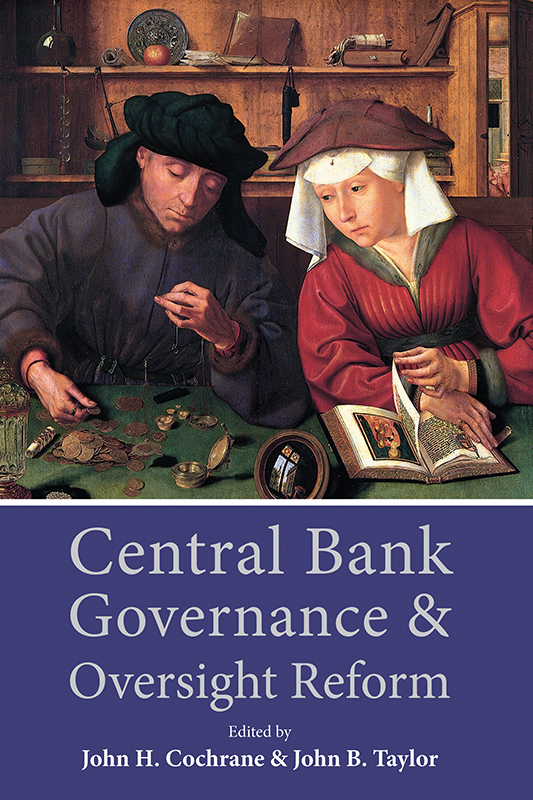(My modest contributions are in the preface and a discussion of Paul Tucker's Chapter 1. I agree it would be nice to have a more rule-based approach to lender of last resort and bailout functions, but wouldn't lots of equity so you don't have to mop up so often be even better?)
This is part of an emerging series of monetary policy conferences at Hoover. Tomorrow we will have a conference on international monetary policy. Stay tuned...
The blurb:
How can we balance the central bank’s authority, including independence, with accountability and constraints? Drawn from a 2015 Hoover Institution conference, this book features distinguished scholars and policy makers’ discussing this and other key questions about the Fed. Going beyond the simple decision of whether to raise interest rates, they focus on a deeper set of questions, including, among others, How should the Fed make decisions? How should the Fed govern its internal decision-making processes? What is the trade-off between greater Fed power and less Fed independence? And how should Congress, from which the Fed ultimately receives its authority, oversee the Fed?The contents:
The contributors discuss, for instance, whether central banks can both follow rule-based policy in normal times but then take a discretionary, do-what-it-takes approach to stopping financial crises. They evaluate legislation, recently proposed in the U.S. House and Senate, that would require the Fed to describe its monetary policy rule and, if and when the Fed changed or deviated from its rule, explain the reasons. And they discuss to best ways to structure a committee—like the Federal Open Market Committee, which sets interest rates—to make good decisions, as well as offer historical reflections on the governance of the Fed and much more. They conclude with an important reminder: how important it is to have a “healthy separation between government officials who are in charge of spending and those who are in charge of printing money,” the most essential part of good governance.
Preface
By John H. Cochrane and John B. Taylor
Chapter 1: How Can Central Banks Deliver Credible Commitment and Be “Emergency Institutions”?
By Paul Tucker
Chapter 2: Policy Rule Legislation in Practice
By David H. Papell, Alex Nikolsko-Rzhevskyy and Ruxandra Prodan
Chapter 3: Goals versus Rules as Central Bank Performance Measures
By Carl E. Walsh
Chapter 4: Institutional Design: Deliberations, Decisions, and Committee Dynamics
By Kevin M. Warsh
Chapter 5: Some Historical Reflections on the Governance of the Federal Reserve
By Michael D. Bordo
Chapter 6: Panel on Independence, Accountability, and Transparency in Central Bank Governance
By Charles I. Plosser, George P. Shultz, and John C. Williams

It would be great if the videos from tomorrow's conference were available afterwards...
ReplyDeleteNice Matsys cover.
I agree with John Cochrane. Banks should have a nice thick equity cushion, and then another thick layer of convertible bonds.
ReplyDeleteAfter that, I don't think that Federal bank bailouts are actually such a bad thing. Such a bailouts would happen usually in a deep recession, and the Fed could simply print up more money and recapitalize the bank that way. I doubt that rescuing banks would be much inflationary even with the money printing involved-- -and this happens only after equity and convertible Bond holder classes are totally wiped out.
I think a 20% equity cushion backed up by a 20% convertible bond cushion would be adequate, but these percentages are off the top of my head.
I prefer 25% equity/capital, plus 25% convertible bond, for 50% total. I also support 50% equity. I doubt that many bailouts would be needed if they only happen after 50% is wiped out.
ReplyDelete